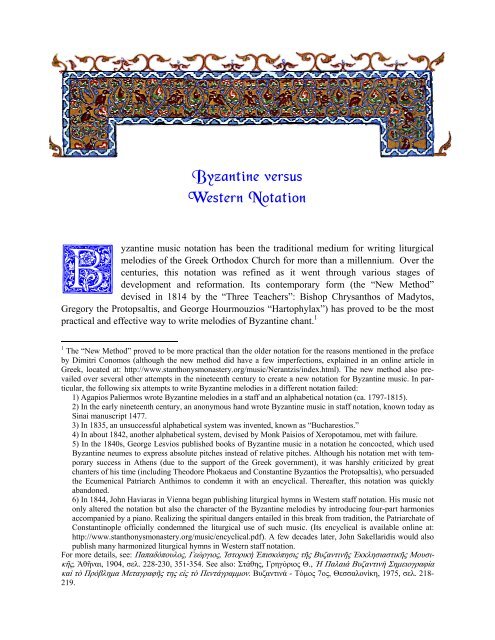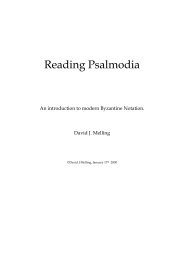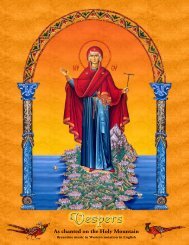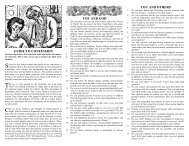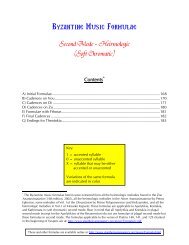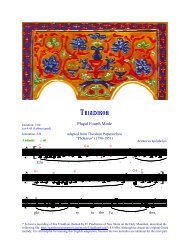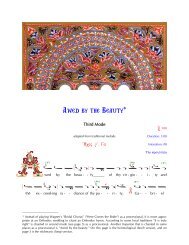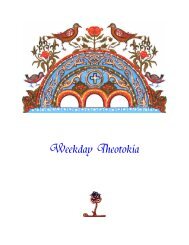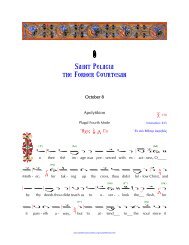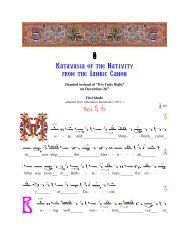Byzantine versus Western Notation - St. Anthony's Monastery
Byzantine versus Western Notation - St. Anthony's Monastery
Byzantine versus Western Notation - St. Anthony's Monastery
Create successful ePaper yourself
Turn your PDF publications into a flip-book with our unique Google optimized e-Paper software.
<strong>Byzantine</strong> <strong>versus</strong><strong>Western</strong> <strong>Notation</strong><strong>Byzantine</strong> music notation has been the traditional medium for writing liturgicalmelodies of the Greek Orthodox Church for more than a millennium. Over thecenturies, this notation was refined as it went through various stages ofdevelopment and reformation. Its contemporary form (the “New Method”devised in 1814 by the “Three Teachers”: Bishop Chrysanthos of Madytos,Gregory the Protopsaltis, and George Hourmouzios “Hartophylax”) has proved to be the mostpractical and effective way to write melodies of <strong>Byzantine</strong> chant. 11 The “New Method” proved to be more practical than the older notation for the reasons mentioned in the prefaceby Dimitri Conomos (although the new method did have a few imperfections, explained in an online article inGreek, located at: http://www.stanthonysmonastery.org/music/Nerantzis/index.html). The new method also prevailedover several other attempts in the nineteenth century to create a new notation for <strong>Byzantine</strong> music. In particular,the following six attempts to write <strong>Byzantine</strong> melodies in a different notation failed:1) Agapios Paliermos wrote <strong>Byzantine</strong> melodies in a staff and an alphabetical notation (ca. 1797-1815).2) In the early nineteenth century, an anonymous hand wrote <strong>Byzantine</strong> music in staff notation, known today asSinai manuscript 1477.3) In 1835, an unsuccessful alphabetical system was invented, known as “Bucharestios.”4) In about 1842, another alphabetical system, devised by Monk Paisios of Xeropotamou, met with failure.5) In the 1840s, George Lesvios published books of <strong>Byzantine</strong> music in a notation he concocted, which used<strong>Byzantine</strong> neumes to express absolute pitches instead of relative pitches. Although his notation met with temporarysuccess in Athens (due to the support of the Greek government), it was harshly criticized by greatchanters of his time (including Theodore Phokaeus and Constantine Byzantios the Protopsaltis), who persuadedthe Ecumenical Patriarch Anthimos to condemn it with an encyclical. Thereafter, this notation was quicklyabandoned.6) In 1844, John Haviaras in Vienna began publishing liturgical hymns in <strong>Western</strong> staff notation. His music notonly altered the notation but also the character of the <strong>Byzantine</strong> melodies by introducing four-part harmoniesaccompanied by a piano. Realizing the spiritual dangers entailed in this break from tradition, the Patriarchate ofConstantinople officially condemned the liturgical use of such music. (Its encyclical is available online at:http://www.stanthonysmonastery.org/music/encyclical.pdf). A few decades later, John Sakellaridis would alsopublish many harmonized liturgical hymns in <strong>Western</strong> staff notation.For more details, see: Παπαδόπουλος, Γεώργιος, Ἱστορικὴ Ἐπισκόπησις τῆς Βυζαντινῆς Ἐκκλησιαστικῆς Μουσικῆς,Ἀθῆναι, 1904, σελ. 228-230, 351-354. See also: Στάθης, Γρηγόριος Θ., Ἡ Παλαιὰ Βυζαντινὴ Σημειογραφίακαὶ τὸ Πρόβλημα Μεταγραφῆς της εἰς τὸ Πεντάγραμμον. Βυζαντινά - Τόμος 7ος, Θεσσαλονίκη, 1975, σελ. 218-219.
ii<strong>Byzantine</strong> vs. <strong>Western</strong> <strong>Notation</strong>In recent times however (primarily since the late nineteenth century), many <strong>Byzantine</strong>melodies have been transcribed into <strong>Western</strong> staff notation. Although this has made <strong>Byzantine</strong>melodies more accessible to the <strong>Western</strong> world, such transcriptions have the following drawbacks:1) <strong>Byzantine</strong> notation 2 contains several qualitative symbols that describe how a particularnote or group of notes should be chanted. <strong>Western</strong> notation also possesses many qualitativesymbols, but most of them are inapplicable to <strong>Byzantine</strong> chant.2) <strong>Byzantine</strong> melodies are, for the most part, an amalgamation of specific melodic formulae.These melodic formulae can be easily recognized by a chanter when they are written as aparticular combination of neumes. When they are written in <strong>Western</strong> notation, however, theycannot be so readily recognized. As a result, they will tend to be executed in a dry manner,note-by-note, rather than as a flowing musical phrase. Furthermore, these melodic formulaeconsist of nuances that are not expressly written even in <strong>Byzantine</strong> notation. Nevertheless,when an experienced chanter recognizes the melodic formula, he will add these nuances in accordancewith the tradition. On the other hand, in <strong>Western</strong> notation this is less likely to occur,since the chanter will not recognize the melodic formula.3) Because <strong>Byzantine</strong> notation is descriptive, it grants an experienced chanter the freedomto add to a melody the embellishments he has learned through oral tradition. The same scoremay also be executed slightly differently by another experienced chanter who hails from a different“school” of <strong>Byzantine</strong> music. Furthermore, the same score may also be used by a beginnerto chant in a simple manner. On the other hand, <strong>Western</strong> notation is usually assumed to bedeterminative, and as such it eliminates all such freedom of interpretation. 3 A more seriousdrawback resulting from this determinative aspect is that <strong>Byzantine</strong> melodies written in <strong>Western</strong>notation are necessarily either too analytical or too simplified.4) <strong>Western</strong> notation describes a melody in terms of absolute pitches, whereas <strong>Byzantine</strong>notation describes a melody as relative pitches within a particular predefined scale. This kindof notation makes vocal music easier and more intuitive to execute, especially if the melodyconsists predominantly of small jumps, as does <strong>Byzantine</strong> music. A small advantage of thisrelativity of <strong>Byzantine</strong> notation is that it grants chanters the flexibility to transpose easily a musictext to an appropriate key, depending on their vocal range or on the pitch of the priests’ petitions.This is only a small advantage, since music in <strong>Western</strong> notation can also be transposed2 For the sake of brevity, the remainder of this essay will use the term “<strong>Byzantine</strong> notation” to denote the aforementionedpost-<strong>Byzantine</strong> notation of the three teachers. Likewise, the term “<strong>Western</strong> notation” will be used hereafterto refer to the contemporary <strong>Western</strong> staff notation that has been used as the standard for compositions in theWest since the seventeenth century.3 To repeat the words of Professor Demetrios Giannelos quoted in footnote #43 of our introduction: “A descriptivenotation, such as that of <strong>Byzantine</strong> music, describes the essentials of the piece, leaving to oral tradition the task ofcompleting with precision whatever is not described. On the contrary, a determinative form of writing, such as<strong>Western</strong> notation with staves, determines with great precision the manner of execution, to the point that the interpretationof the person executing it is delineated by factors that depend directly on the definitive indications of themusic symbols. These indications can be so absolutely restricting that they preclude all room for interpretation.”
<strong>Byzantine</strong> vs. <strong>Western</strong> <strong>Notation</strong> iiiwithout too much difficulty, especially if it is based on a solfa (Do-Re-Mi) system. However, agreater advantage of this relativity becomes evident when modulations come into play, especiallywhen they are introduced on notes that are not their natural tonics. The score in <strong>Byzantine</strong>notation remains the same notationally, and is thus easily recognizable as a phrase, whereasthe same music written in <strong>Western</strong> staff notation may result in nonstandard key signatures ornumerous accidentals, and as such will not be easily recognized as a phrase. As a result, suchmusic becomes extremely difficult to sight-read. To see an example of this difficulty, comparethe following transcriptions in English of the end of the five-mode “Kyrie Eleison” by NileusKamarados, and notice how burdened with accidentals the version in <strong>Western</strong> notation is:LGrave Mode ord,_______̃have_______Ì mer - ƒ-ƒƒƒcy. ƒƒLord,___ÌÌhave_______Ì ƒmerƒƒ- cy. ƒ Lord,_ ƒƒ____Ì ƒƒhave________̃ ƒmer - - - - - ƒƒcy. ƒƒLord,_______have_____ ƒmer - cy. ƒLord,___̃have____Ì ƒmer - - ƒcy. ƒLord,___Ìhave ƒmer - - - - - - - cy.
iv<strong>Byzantine</strong> vs. <strong>Western</strong> <strong>Notation</strong>5) <strong>St</strong>andard <strong>Western</strong> notation is incapable of accurately expressing the proper intervals of<strong>Byzantine</strong> music. Although it can approximate most <strong>Byzantine</strong> scales such that the error isnever greater than 2 μόρια (33 cents), it cannot approximate the scale of the soft chromatic modalgenre without producing an error of less than 4 μόρια (67 cents). This large error considerablyalters the ὕφος (the “hue”) of troparia in this modal genre. (This problem is discussed atgreater length online at: http://www.stanthonysmonastery.org/music/Chromatic.htm)6) Many people familiar with <strong>Western</strong> music have learned to associate music written in<strong>Western</strong> notation with a certain style of singing that is foreign to the traditional style of <strong>Byzantine</strong>chant. For example, some of them might tend to sing music in <strong>Western</strong> notation with excessivevibrato, with a subtle crescendo on every note, or in a disjunctive manner (i.e., by silencingtheir voice for a fraction of a second before beginning the next note). Although <strong>Byzantine</strong>notation in and of itself will not hinder such people from applying this same <strong>Western</strong> styleof singing to it, it will nevertheless serve as a visual reminder that <strong>Byzantine</strong> chant is quite differentfrom <strong>Western</strong> singing.Although the words “sing” and “chant” in English can both be used in reference to executingliturgical music, we prefer to use the word “chant” instead of “sing” in order to preserve thesame distinction that exists between the corresponding words in Greek. Photios Kontoglou ofblessed memory (1895-1965) explained that the distinction between these two terms in Greeklies in the spiritual differences between secular and ecclesiastical music. In particular, he wrote:“Spiritual feelings are expressed only by ecclesiastical music. Only ecclesiastical music canexpress the secret movements of the heart, which are completely different than what worldlymusic expresses. For this reason, the two kinds of music [European and <strong>Byzantine</strong>] are totallydifferent, just as shown by the words ‘sing’ (τραγουδῶ) and ‘chant’ (ψάλλω).” 47) The rules of standard <strong>Western</strong> notation dictate that a new time signature be insertedwithin a melody every time the rhythm changes. But since <strong>Byzantine</strong> melodies are characterizedby syllabic rhythm (i.e., the rhythm is derived from the pattern of accentuated syllables),such melodies transcribed into <strong>Western</strong> notation would be burdened by dozens of time signatures,thus rendering the score awkward. Moreover, melodies written in <strong>Byzantine</strong> notation caneasily be annotated with “abridged rhythm” (συνεπτυγμένος ρυθμός), which, in the words ofDemetrios Sourlantzis, lends the melodies “grandeur, solemnity, modesty, sacredness, and nobility.”58) <strong>St</strong>andard <strong>Western</strong> notation has key signatures for music only in the major and minorkeys. <strong>Byzantine</strong> music, however, consists of many modes that are neither major nor minor (e.g.,the hard chromatic modal genre, the diatonic grave mode, etc.). Therefore, in order to writesuch melodies in <strong>Western</strong> notation, one must either devise a non-standard key signature or burdenthe score with repeated accidentals.4 Translated from a radio broadcast available online at: www.analogion.com See also: Cavarnos, Constantine, <strong>Byzantine</strong>Sacred Art. Institute of <strong>Byzantine</strong> and Modern Greek <strong>St</strong>udies, Belmont, Massachusetts, second editon,1992, p. 148.5 Σουρλαντζῆ, Δημητρίου Γ., Βυζαντινὴ Θεία Λειτουργία, Θεσσαλονίκη, 1992, σελ. στʹ.
<strong>Byzantine</strong> vs. <strong>Western</strong> <strong>Notation</strong> v9) There are more than 100 orthographical rules for <strong>Byzantine</strong> music notation (which wehave compiled in English at: http://www.stanthonysmonastery.org/music/ByzOrthography.pdf)that determine when, for example, a petastē must be used instead of a psēfistón. There are alsohundreds of unwritten formulaic rules for <strong>Byzantine</strong> music that dictate which melodies arepermissible for a given syllabic pattern. Combined, these rules help to ensure that new compositions(in any language) remain within the bounds of traditional <strong>Byzantine</strong> music, while stillallowing for creativity. New compositions, however, can stray from these traditional boundsmore easily when written in <strong>Western</strong> notation, since composers can write an untraditional musicalline without readily realizing that they have deviated from the traditional musical formulae.10) A person who knows <strong>Byzantine</strong> music notation has access to the vast repertoire of thetraditional music of the Greek Orthodox Church in its purest form, whereas one who knowsonly <strong>Western</strong> notation must either rely on the few existing transcriptions of <strong>Byzantine</strong> music(with all their aforementioned drawbacks) or, even worse, resort to singing modernistic compositions,most of which have strayed far from the style of traditional <strong>Byzantine</strong> music.* * *The only significant drawback to <strong>Byzantine</strong> notation is that it is harder to learn than <strong>Western</strong>notation. There are only about twenty symbols in <strong>Western</strong> notation that one needs to knowin order to read simple vocal music (such as the transcriptions in our website). Since a largenumber of people in contemporary <strong>Western</strong> society have been introduced to this notation earlyin their lives, many can become proficient at sight-reading such music with relatively little effort.<strong>Byzantine</strong> notation, on the other hand, has about one hundred symbols and combinationsof symbols that need to be learned, and few people in the West have ever even seen this notationbefore in their lives. Nevertheless, the task of learning it is by no means insurmountable.Proof of this is the many people throughout the <strong>Western</strong> world who have managed to learn itthrough books and recordings of traditional chanters, with little or no help of a teacher. Experiencehas shown that one can learn <strong>Byzantine</strong> notation in less than a week. 6If one is interested in learning <strong>Byzantine</strong> notation well (i.e., not just figuring out the mechanicsof <strong>Byzantine</strong> chant, but achieving a certain degree of proficiency in this sacred artform), the best way to do so is to find a teacher who can give private lessons. But since teacherscan be difficult to find, the next best way to begin learning is with the audio-visual resourcesavailable online. These resources are listed in our “<strong>Byzantine</strong> Music Links” page, located at:http://www.stanthonysmonastery.org/music/Links.htm. We suggest beginning with the link“Teach Yourself <strong>Byzantine</strong> <strong>Notation</strong>: exercises with recordings, by Margaziotis.”6 Gregorios <strong>St</strong>athis, a professor of music in Athens, once visited the Republic of Georgia and attempted to teach<strong>Byzantine</strong> notation to forty men and women who had never seen it before in their lives. After spending six hourswith him every day for six days, without difficulty they learned to chant not only simple troparia but even elaboratecompositions written in <strong>Byzantine</strong> notation.


